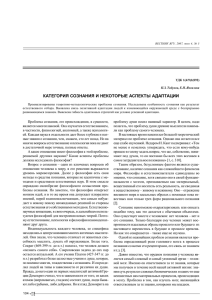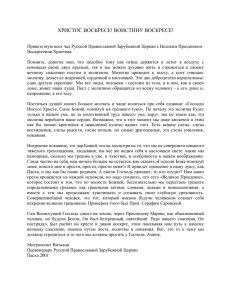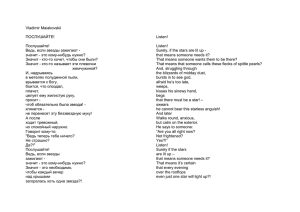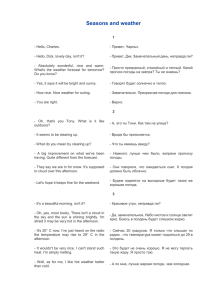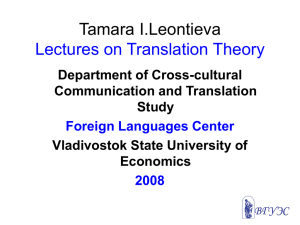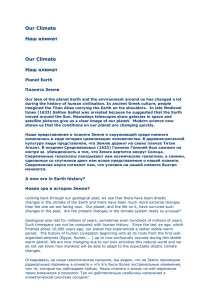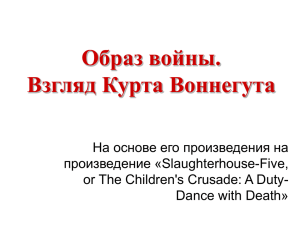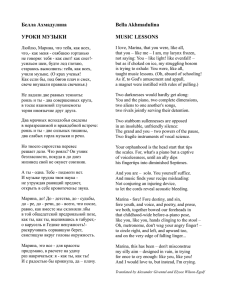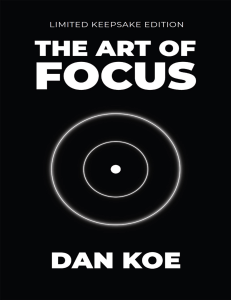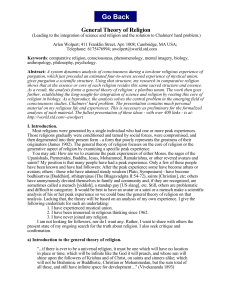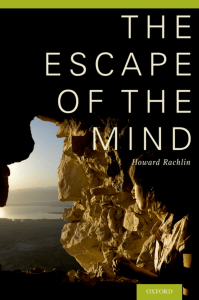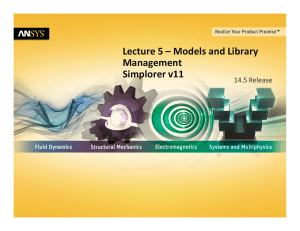Mamardashvili, Symbol and Consciousness
реклама
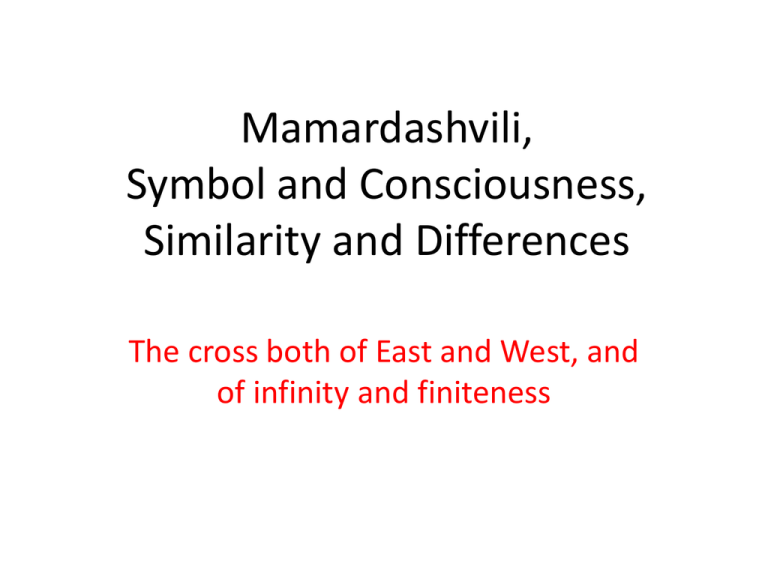
Mamardashvili, Symbol and Consciousness, Similarity and Differences The cross both of East and West, and of infinity and finiteness Vasil Penchev [email protected], [email protected] http://www.scribd.com/vasil7penchev http://www.wprdpress.com/vasil7penchev CV: http://old-philosophy.issk-bas.org/CV/cvpdf/V.Penchev-CV-eng.pdf The objectivity It is the works and personality, and even life of the great philosopher Merab Mamardashvili to be interpreted as a sufferance and crucifixion between Consciousness W E Thought e a s s Human Being t t Symbol The way this conference to be addressed: “East and West” as a crucifixion between the wholeness of symbol and the necessity to be expressed in a partial way to be articulated and realized by consciousness That crucifixion is thought at all as well as any thought, but reflection, the philosophical thinking is just that sufferance and suffering on the cross “each and any minute”, the effort of human being to be a human being The way this conference to be addressed: “Similarities and Differences” as the similarity of the oneness before crucifixion both “and” and “versus” the differences of plurality after crucifixion There is anyway some mystery or sacrament after all because the oneness resurrects unifying those “Similarities and Differences” as a common and joint whole Even more, that crucifixion is the true or even single way for the oneness of thought to be: Thought is only that philosophical suffering or human sufferance ... This way of interpretation as a philosophical effort, suffering, thinking ... ... suggests the spirit of Mamardashvili to be put to death again and again to be able to resurrect How? Representing it a simple scheme as before and thus as an infinite bad repetition in as Mamardshivili figured and described Inferno. He used to utilize metaphors and similes in a visible effort and crucifixion to express and think the inexpressible to be in it, in philosophy, in human being: In himself in final analysis Let us, after him, involve a scientific concept, that of fractal as a metaphor for thought rather than a notion The fractal of that interpretation ... ... is a suffering and thus disturbing crystallization Its germ will be sought after “Symbol and Consciousness” (with Alexander Piatigorsky as his coauthor) and devoted to the return of the Western philosophy into its symbol of thought Crucifixion and return, crucifixion and resurrection is the initial sacrament of philosophy as if represented by both coauthors and close friends Gori, Georgia This is the birthplace of Mamardashvili ... and of Stalin. Georgia is situated just on the crossroads of Asia and Europe therefore symbolizing even by its historical destiny the crucifixion and unification between East and West: The Cross, Crucifixion is the Georgian Flag: Its name is “Five Cross Flag” Mamardashvili against national exclusivity However Mamardashvili categorically opposed any nationalism either Russian or Georgian, or any other one as well as the idea of national exclusivity in general Mamardashvili touched the essence both of thought and of philosophical reflection being a Georgian: He managed to reveal that deep level in the Georgian or Russian soul, which is universal for philosophy, thought and mankind, and in relation of which, of the task of thought, any nationalism or pretense of national exclusivity is only a huge obstacle Five Cross Flag as a fractal well visualizes the metaphor of fractal as “three in one”: hierarchy, multiplication, repetition They can unfold in a “bad infinity” of national history, from which nobody learn anything as Mamardashvili said. However the metaphor of fractal can also serve to represent the holding unity of symbol unfolding itself as an infinite series of signs in consciousness. The monotonic, mechanical repeatability of those signs kills both the thought and symbol, though Consciousness on the Cross The consciousness is crucified by two opposed trends: It should manage to keep the symbol without any simple repetition in a “bad infinity”, which puts it to death It should manage to keep the symbol in creativity without chaos to tear it to pieces Even more, consciousness really exists only on that Cross, in its Centre, in the oneness of both tearing it trends: It is a constant effort again and again to be Five citations from “Symbol and Consciousness” The understanding of symbol as not-sign: symbol is the sign of nothing Less and less symbols: from the situation of understanding to the situation of knowledge The objectivity of the book is the interpretation of symbol in a sense of consciousness Consciousness hides itself “in itself” Consciousness and culture are actively progressing incompatible to each other Five citations from “Symbol and Consciousness” 2. 3. 1. 4. 5. 2. “понимания символа как незнака”; “символ в собственном смысле есть знак ничего” the understanding of symbol as not-sign: symbol is the sign of nothing 3. “в мировосприятии современного культурного человека символов становится все меньше и меньше внутри наших знаковых систем”: “символы переходят (‘переводят нас’) из ситуации понимания в ситуацию знания” Less and less symbols: from the situation of understanding to the situation of knowledge 4. “сознание как таковое - с установкой на полное, максимальное понимание - от нас уходит (или, как сказали бы древние индийцы, ‘уходит в себя’)” Consciousness hides itself “in itself” 5. “сознание и культура выявляют в отношении друг друга такое свойство, как активная прогрессирующая несовместимость” Consciousness and culture are actively progressing incompatible to each other 1. “ Цель этой книги истолкование символа в смысле сознания” The objectivity of the book is the interpretation of symbol in a sense of consciousness Three preliminary notes concerning: • The “cross” of ‘finiteness – infinity’ and ‘symbol – consciousness’ • The “cross” of ‘externality – internality’ and ‘symbol – consciousness’ • The “cross” of ‘differences – similarity’ and ‘symbol – consciousness’ These three “crosses” are one and the same in a sense unifying and unified by ‘symbol – consciousness’, which will be explicated a little below ‘Finiteness – infinity’ and ‘symbol – consciousness’ • Both symbol and consciousness are rather on the side of infinity, but both can explicate themselves into finiteness correspondingly as signs or “structures of consciousness” • Though the following property of them is too paradoxical, both are equivalent to their finite representations as signs or structures being random • Thus both symbol and consciousness guarantee choice, freedom, freewill and responsibility which are necessary for that equivalence ‘Externality – internality’ and ‘symbol – consciousness’ • Symbol is rather external in relation to an observer while that observer is always internal in relation to consciousness • Thus symbol and consciousness represent the oneness of the totality split by the availability of any observer necessary internal to it (being ‘total’) • Thus symbol represents the externality of the totality in relation to any observer as the true totality contents its externality in itself being just ‘total’ A visualization: The totality as a whole is within itself as symbol OO An Observer ‘Differences – similarity’ and ‘symbol – consciousness’ • Both symbol and consciousness unlike correspondingly signs or structures are on the side of similarity, even of the oneness • That similarity is decomposed into identities and differences representable by signs (outside) or structures of consciousness (inside) • The signs, to which the observer is external, can be manipulated in mental operations • The structures of consciousness, to which the observer is internal, allow of the being to be ordered How can these three “crosses” be one and the same? • Of course, all three are only signs referring to some hidden symbol, which unifies them remaining hidden and explicable in principle, and thus allowing of new and new signs again and again • The philosophical reflection is concentrated on that suffering birth of the signs rather than on their meaning or on the symbol, which they cannot ever represent • Thus Mamarrdashvili philosophically thought of Georgia constantly crucified in the initialization of the West from the East 2. The understanding of symbol as notsign: symbol is the sign of nothing • Symbol is not a sign of anything: If any sign refers to other signs, which precede or follow it, symbol does not refer to anything both as it is the beginning of all signs, which it generates, and as there is a leap from it to any ensemble of signs generated by it • Symbol is just the sign of nothing as it refers only to the totality, however to the “other side” of it, outside, its externality, from which it is nothing 3. Less and less symbols in the “West”: from the situation of understanding to the situation of knowledge • The “West” as on west as on east lives in the established structures of signs, which one should know to be socialized: sign structures as language, society, science, technics, and even religion. However one does not need to understand them to utilize them. They require only knowledge • New sign structures therefore directly addressing symbols appear extremely rare while the above ones are developed, and their symbolic origin is redundant and forgotten From symbol to consciousness “outside” • The first two citations refer to “symbol”, and the next two ones to consciousness. This suggest the consciousness to be entered in a way hidden for any sign or conscious structures, namely outside, from the side of symbol: A visualization: Sign or conscious OO An Observer 4. Consciousness hides itself “in itself” • That way “outside” can display why and how consciousness can hide and hides itself “in itself” being referring to symbol: • It hides itself “in itself” in relation to any sign or conscious structures as it is only their or any wholeness • On the contrary, all sign or conscious structures constitute themselves about their expansion only which is able to guarantee their openness. Thus they are partial in principle to be A reference to Heidegger ... • Let consciousness be entered “outside”, from the “side” of symbol and hidden for any observer if that one identifies oneself by any knowledge of any structures; • If that is the case, consciousness is only openness, unhiddenness, ἀλήθεια, the way, in which Heidegger introduces truth as entering the totality (Here “consciousness” is only a sign of the totality) 5. Consciousness and culture are actively progressing incompatible to each other • After consciousness has been understood as pure openness from the side of symbol, and culture as an established sign structure, by which the observer orders the world, their incompatibility is obvious • Even more, the development of culture being the extension and intensification of a sign structure wanders from the symbol. They frustrate each other more and more: signs vs. symbol just as culture vs. consciousness ... • Nevertheless consciousness is just the sign structure of culture. It hides itself by itself again ... 1. The interpretation of symbol in a sense of consciousness • This is the unifying center of the book “Symbol and Consciousness”. However this is a tautology: The four terms: interpretation, symbol, sense, and consciousness mean one and the same: • The book hides itself in itself by itself just where it reveals its objectivity and thus essence • Symbol and consciousness is only a doubling, two terms about one and the same, however ... Symbol and consciousness as pure doubling • ... however that doubling and further its redoubling in sings or structures generate the world • If one starts from the signs and structures, symbol and consciousness is not anything different from them. They are not more than signs and structure, but seen once again, in their wholeness • “A man sees mountains and a sea, the pupil sees something different, but the wise man sees again mountains and a sea” A note about time and language Time can be considered as the condition of language and thus for extending a sign or conscious structure: Time can be thought as an initial and primary language of the being, in which the signifier and signified coincide with each other and thus with the sign in principle generating the “things themselves” as “phenomena” However Mamardashvili and Piatigosrsky’s symbol should think beyond or before even that “phenomenon”, i.e. before or beyond the time, namely by the sign of “death” as transcending the time Another note: Time and Totality • Both “Symbol and Consciousness” should to be realized in terms of the totality: • Time expresses the totality thoroughly, nevertheless an inexplicable remainder appears always (Derrida coined the term of “mute difference” written as “differance” to explicate it somehow anyway) • However both time and the totality and thus symbol and consciousness are neither subjective nor objective though they can be interpreted in both ways These four motifs (2-5) ... • ... can be seen as originating from a central motif (1), originating from nowhere and therefore being a simple tautology or doubling and redoubling ... • In turn these four motifs can be followed in other papers of Mamardashvili extending a fractal structure of (“)Symbol and Consciousness(“) as what the flag of Georgia is: Five Cross Flag five times: Five Cross Flag five times: The key for decoding • Any fractal structure contents the key to be decoded in itself and by itself • If any other language as some encoding is conventional and thus requires an external vocabulary as a key to be decoded, the fractal structure is also its key and thus it is natural, being, and existing unlike any other language, which is artificial referencing to some other knowledge of interpretation 2.2. God (in culture) is a symbol of some force compensating the deficiency in our efforts • В культуре (а не в религии) Бог – это символ некоторой силы, которая действует в мире вопреки нашей глупости, непониманию, неумению или нежеланию понимать некоторые состояния, к которым мы не могли прийти своими собственными силами, но которые тем не менее являются фактами - БЫТЬ ФИЛОСОФОМ – ЭТО СУДЬБА 2.3. Modified objects (e.g. irrational expressions) are signs (symbols) of the difference between being and consciousness • превращенные объекты (иррациональные выражения, «желтые логарифмы») как знаки, «свидетельства» неустранимого различия между бытием и сознанием, как символы того, что при всей слитости в некотором общем континууме бытие и сознание не могут быть отождествлены ПРЕВРАЩЕННЫЕ ФОРМЫ. О НЕОБХОДИМОСТИ ИРРАЦИОНАЛЬНЫХ ВЫРАЖЕНИЙ” 2.4. No subject for any symbol, e.g. for that of “the supreme good” in particular • Я уже ввел понятие "высшего блага", точнее, символ - не понятие, поскольку оно, как сказал бы Кант, не имеет созерцания, на котором оно могло бы быть разрешено. То есть под это понятие нельзя подставить никакой конкретный предмет - ПРОБЛЕМА ЧЕЛОВЕКА В ФИЛОСОФИИ 2.4+The human being is always “selfmaking”, its state consists of births again and again Таким образом, человек - это, очевидно, единственное существо в мире, которое (как человеческое существо, в том смысле, что оно не порождается Природой, которую мы можем изучать объективированно - в какой-то картине, отвлеченной от себя) находится в состоянии посеянного зановорождения, … ПРОБЛЕМА ЧЕЛОВЕКА В ФИЛОСОФИИ 2.4++ The human being is being born all over again and again by means of symbols: both in religion and in philosophy ... и это зановорождение случается лишь в той мере, в какой человеку удается собственными усилиями поместить себя в свою мысль, в свои стремления, в некоторое сильное магнитное поле, сопряженное предельными символами. Эти символы на поверхности выступают, с одной стороны, в религии (точнее, в мировых религиях, то есть не этнических, не народных), а с другой стороны, в философии - ПРОБЛЕМА ЧЕЛОВЕКА В ФИЛОСОФИИ 2.5. Symbol is what are ourselves, and understand always only incompletely. The philosophical works are that incompleteness expressed in infinite expression Символ (не знак!) всегда есть то, что мы не до конца понимаем, но что есть мы сами как понимающие, как существующие. И наши философские произведения, и их чтение есть форма существования этого до конца непонимаемого, его бесконечной длительности и родственной самосогласованности - ФИЛОСОФИЯ – ЭТО СОЗНАНИЕ ВСЛУХ 3.2. There exists philosophy always, the doctrines are optional • Доктрин может не быть, а философия существует - СОВРЕМЕННАЯ ЕВРОПЕЙСКАЯ ФИЛОСОФИЯ (XX век) 3.3. Philosophy is a second “birth” in thought after a symbolic death • определения философии как формы, позволяющей нам испытать то, что без нее мы не могли бы испытать. То есть рождаться второй раз, согласно древнему символу «второго рождения» ФЕНОМЕНОЛОГИЯ – СОПУТСТВУЮЩИЙ МОМЕНТ ВСЯКОЙ ФИЛОСОФИИ 3.3+ Philosophy is an initial germ, which only develops by concepts in an infinite cultural form • И в этом смысле философия является как бы бесконечной культурной формой. То есть она содержит в себе некоторые уже заданные ее целостностью моменты или зерна, которые могут когда-то и кем-то выявляться, развиваться с помощью понятий, но сами возможности этого развития будут содержаться уже в самом факте конституирования философии ФЕНОМЕНОЛОГИЯ – СОПУТСТВУЮЩИЙ МОМЕНТ ВСЯКОЙ ФИЛОСОФИИ 3.4. One creates oneself as a human being again and again by individual efforts Человек создается. Непрерывно, снова и снова создается. Создается в истории, с участием его самого, его индивидуальных усилий. И вот эта его непрерывная создаваемость и задана для него в зеркальном отражении самого себя символом «образ и подобие Божье». То есть Человек есть такое существо, возникновение которого непрерывно возобновляется. С каждым индивидуумом и в каждом индивидууме ФИЛОСОФИЯ – ЭТО СОЗНАНИЕ ВСЛУХ 3.5. “The symbolic element of rationality” is the chapter 5 of “The classical and non-classical ideal of rationality • 5. СИМВОЛИЧЕСКИЙ ЭЛЕМЕНТ РАЦИОНАЛЬНОСТИ – КЛАСИЧЕССКИЙ И НЕКЛАССИЧЕСКИЙ ИДЕАЛЫ РАЦИОНАЛЬНОСТИ 4.2. Consciousness should define only self-referential as producing itself as more consciousness Ну, скажем, в грамотной философии сознание ведь не определяется, а говорится, что сознание есть то, что есть возможность большего сознания. Точно так же и свобода - ПРОБЛЕМА ЧЕЛОВЕКА В ФИЛОСОФИИ В том числе и в поле символов – «человек», «смерть», «смысл жизни», «свобода» и т.д. Это ведь вещи, производящие сами себя. Даже сознание, как и мысль, можно определить как возможность большего сознания - ФИЛОСОФИЯ – ЭТО СОЗНАНИЕ ВСЛУХ 4.3. Well, figure a scientific researcher in the Academy of sciences. Can (s)he have that universal consciousness? • А теперь, представьте научного сотрудника Академии наук. Может ли он иметь то сознание, которое я вам описывал как универсальное? - СОВРЕМЕННАЯ ЕВРОПЕЙСКАЯ ФИЛОСОФИЯ (XX век) 4.4. The consciousness of “cogito” coincides with its contents, doubles it • Итак, когитальное сознание есть ухватывание сознанием в любом осознаваемом содержании самого факта, что "я его сознаю", чем и исчерпывается это содержание как сознательное явление Классический и неклассический идеалы рациональности - Иначе говоря, в данном случае концептуальное сознание происшествия явления совпадает с его содержанием и последнее не может быть отделено от первого 4.5. Speaking of being, speaking of consciousness in a special sense • когда говорится о бытии, то в особом смысле говорится и о сознании НЕОБХОДИМОСТЬ СЕБЯ. ВВЕДЕНИЕ В ФИЛОСОФИЮ 5.2. Culture is infinite: The symbol of death means the transformation in thought being due to our efforts Культура бесконечна. Однако у такого рода бесконечности есть, естественно, и элемент дурной бесконечности. И, более того, выпадение из нее, обращение к мысли обязательно связано с появлением символа смерти, потому что к мысли мы можем прийти, только изменившись, перестав быть прежними. Следовательно, онтологическое устройство бытия воспроизводит себя лишь с включением нашего усилия, когда, во-первых, мы становимся другими, чем были до этого, и, вовторых, приходим к этому нашим непрерывным продолжением самих себя - МЫСЛЬ В КУЛЬТУРЕ 5.3. Consciousness is singulare tantum, a single many-much, or a multiple oneness • Нет множественного сознания. Как говорили мистики – и я с удовольствием повторяю эту формулу – сознание представляет собой singulare tantum, то есть множественное-единственное. Множественную единичность, скажем так НЕОБХОДИМОСТЬ СЕБЯ. ВВЕДЕНИЕ В ФИЛОСОФИЮ 5.4. Human consciousness and its “annex” called civilization • человеческое сознание и связанная с ним «пристройка», называемая цивилизацией СОЗНАНИЕ И ЦИВИЛИЗАЦИЯ 5.5. Struggle with consciousness: It becomes knowledge and ... vanishes • Борьба с сознанием означает, что стремлением человека сознание перестает быть чем-то спонтанным, относящимся к природе, автоматически функционирующим. Сознание становится познанием и на это время (слово "время" здесь не имеет физического смысла) перестает быть сознанием и как бы тановится метасознанием - ТРИ БЕСЕДЫ О МЕТАТЕОРИИ СОЗНАНИЯ” (с Пятигорским) “Symbol and Consciousness” as an extending structure 3.3. 3.2. 2.3. 3.4. 3. 3.5. 4.5. 2.2. 1. 2. 2.4. 2.5. 4. 4.2. 5.5. 5. 5.4. 5.2. 5.3. 4.4. 4.3. Conclusions: Mamardashvili’s philosophy can be thought both as the suffering effort to be a human being again and again as well as the philosophical reflection on the genesis of thought from itself by the same effort Thus it can be recognized as a powerful tension between signs an symbol, between conscious structures and consciousness, between the syncretism of the East and the discursiveness of the West crucifying spiritually Georgia • Быть философом – это судьба (Being a philosopher is destiny) • Классический и неклассический идеалы рациональности (The classical and nonclassical ideal of rationality) • Мысль в культуре (Thought in Culture) • Необходимость себя. Введение в философию (Necessity of Self: Introduction to Philosophy) • Превращенные формы. О необходимости иррациональных выражений (Modified forms. On the necessity of irrational expressions) • Проблема человека в философии (The problem of Human Being in Philosophy) • Символ и сознание (Symbol and Consciousnes) • Современная европейская философия (XX век) (Contemporary European philosophy [20 century]) • Сознание и цивилизация (Consciousness and Civilzation) • Три беседы о метатеории сознания (с Пятигорским) (Three talks [with Piatigorsky] on the metatheory of consciousness) • Феноменология – сопутствующий момeнт всякой философии (Phenomenology is an accompanying entity of any philosophy) • Философия – это сознание вслух (Philosophy is consciousness aloud)
